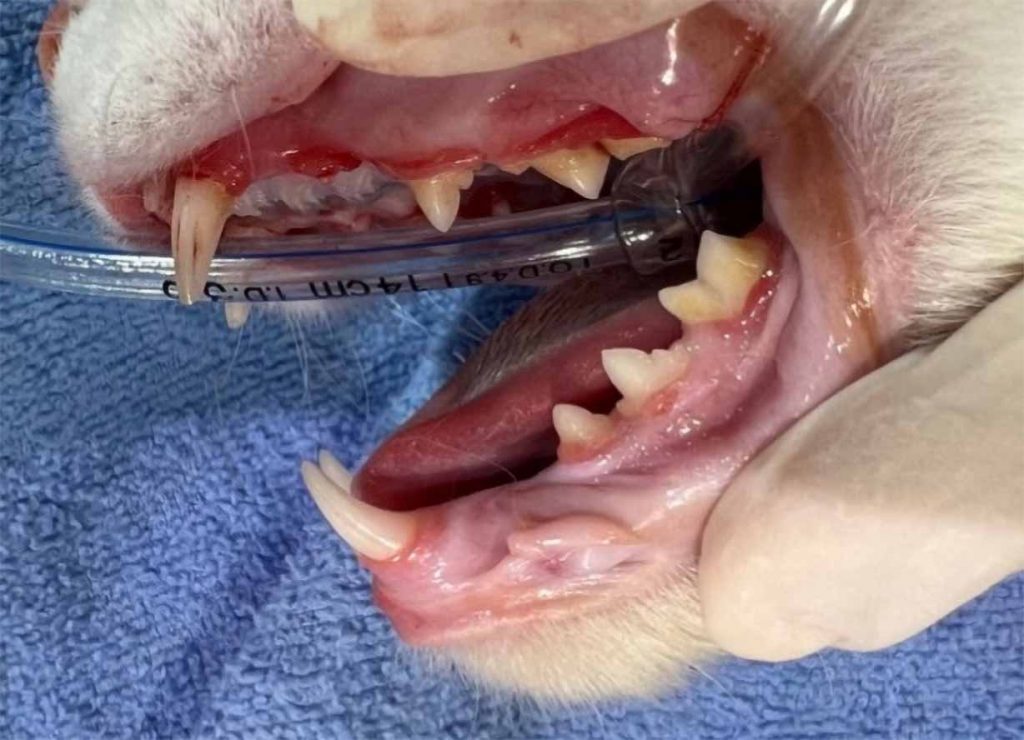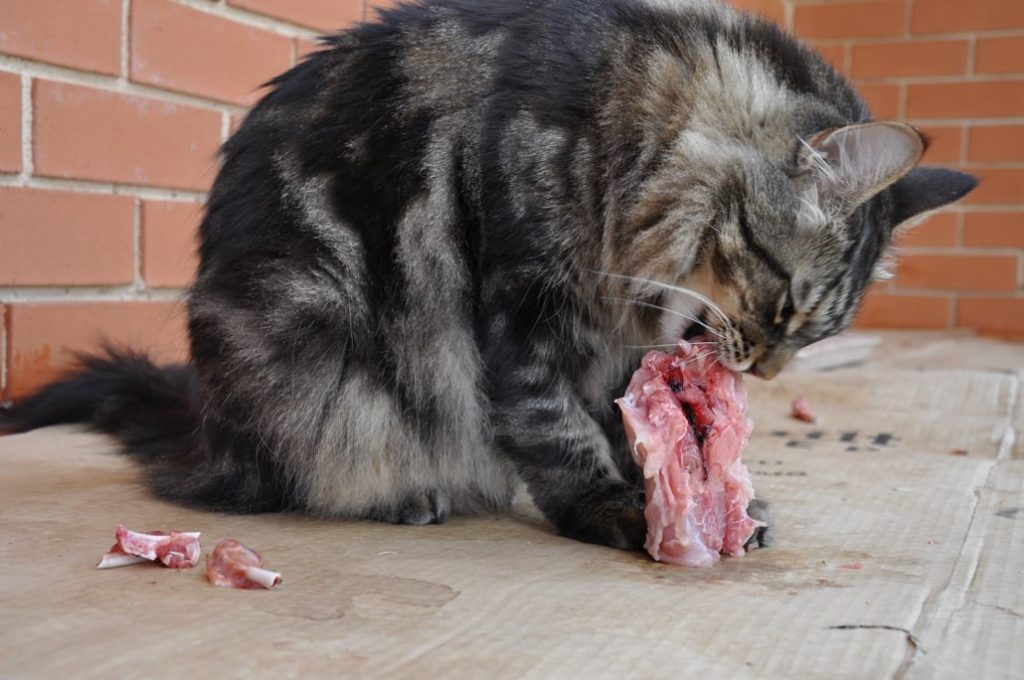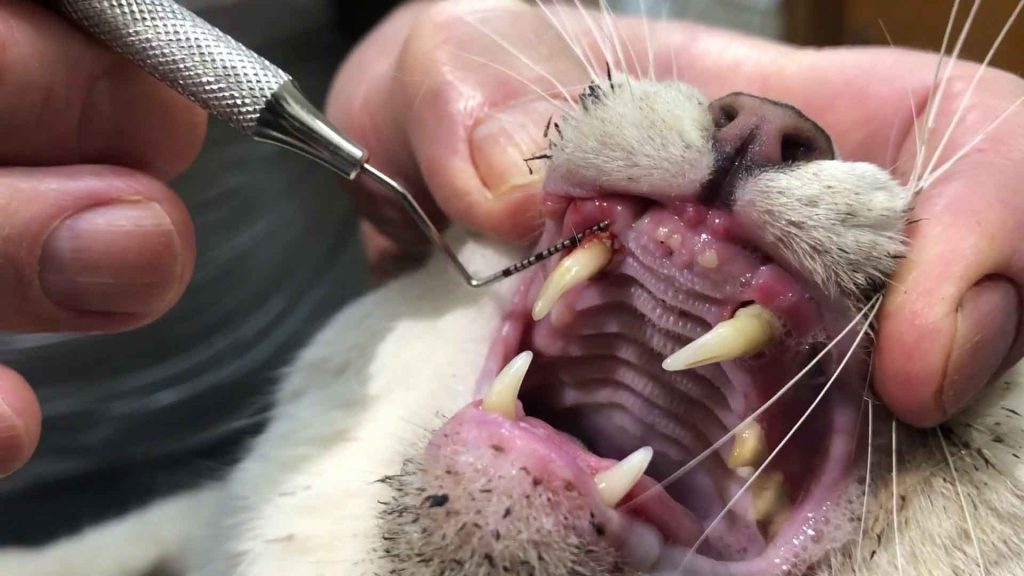Dr. Mei Yam – Bligh Park Pet Health Centre
Pippin’s Case
On 15th December 2022, an email arrived, entitled ‘Feline Gingivostomatitis for Pippin’. Pet owners Jaime and Aaron had recently adopted Pippin, a one-year-old male neutered domestic shorthair cat. Within days of adopting Pippin, Jaime and Aaron realised that Pippin had not been well cared for. He was underweight, infested with fleas, and had weak hindlegs and bad breath.
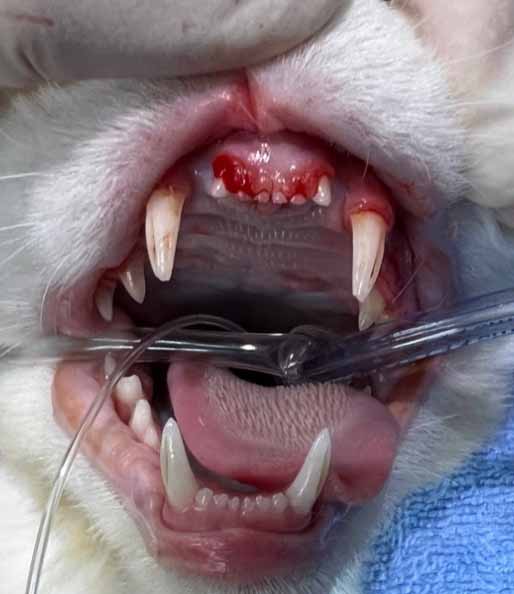


At the first visit with their local vet, it was reported that he had halitosis, severe gingivitis, a large ulcer on the hard palate, and ulceration of the gum on the lower right jaw associated with the actions of the upper molar tooth. At times Pippin was unable to properly close his mouth and appeared to be suffering a lot of pain. The vet’s case notes contain the diagnosis: Feline gingivostomatitis.

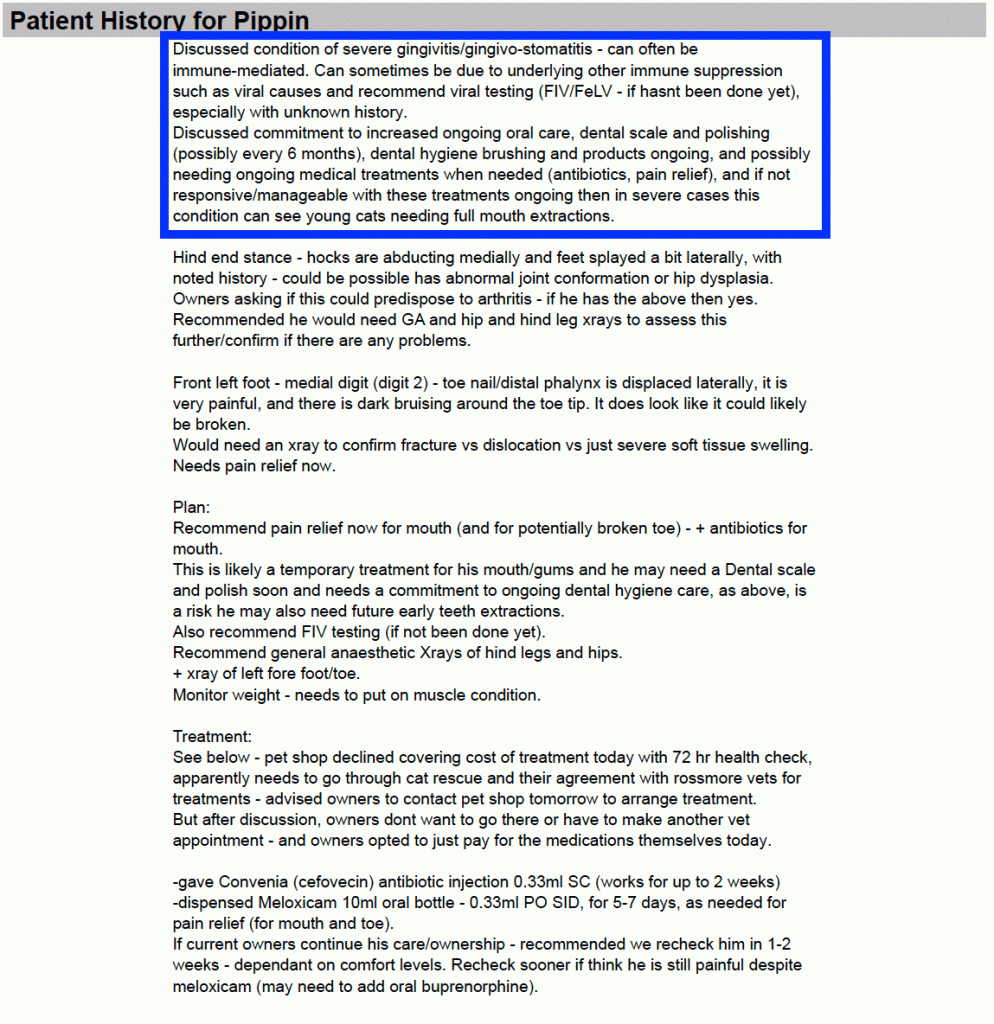
As can be imagined feline gingivostomatitis was a completely new concept for Jaime and Aaron. The vet gave them information leaving them with the clear impression that there was no cure. They were told that a full mouth extraction would likely be required if medications failed to improve his condition. Following that first vet consultation, they returned home with a supply of oral pain relief medication and a course of antibiotics. They continued feeding Pippin Royal Canin dry and wet food—thinking they were doing the right thing.
After a few more vet visits, more rounds of antibiotics, and more times being told that eventually, Pippin’s teeth would need to be removed and with their concerns and hesitations being dismissed, Jamie and Aaron sought to find another way. That’s when, after much searching on the internet, they came across Dr Lonsdale’s YouTube channel and videos listed at www.rawmeatybones.com.
Understanding Gingivostomatitis
Feline gingivostomatitis is a relatively common condition that affects young cats, the prevalence is up to 12% of their population (Vapniarsky et al. 2020)1. The word describes the inflammation of the gums and overall surfaces in the oral cavity, including the tongue, inner surfaces of the lips and/ or the roof and floor of the mouth. This is a painful condition where patients can present with severe redness, congestion and swelling of the gum and/ or with ulcerations of the oral tissues.
The cause of gingivostomatitis is poor oral hygiene. The accumulation of dental plaque bacteria, even in small quantities is adequate to set off a strong local immune response that gives rise to the damage. In addition to plaque bacteria, other infectious agents and underlying immune disorders may contribute to the severity of the condition.
Conventional Veterinary Treatment
Vets are taught that the successful treatment of feline gingivostomatitis requires the reduction of oral bacteria. The conventional methods of treatment include teeth brushing, the use of prescription dental diets and/ or other dental hygiene products. Long-term antibiotic use is recommended. Conventional vets advise that the ‘most effective’ treatment for the condition entails partial or full mouth tooth extractions. The reasoning is that plaque bacteria only live on hard surfaces. By removal of the teeth the bacteria will not have a place to live and consequently not inflame the gums. Conventional vets do not condemn canned and dry junk foods, nor do they advise the use of nature’s remedy: raw meaty bones.
How A Raw Meaty Bones Diet Makes A Difference?
Since it is understood that the treatment for feline gingivostomatitis requires immaculate oral health, the raw meaty bones diet is quite simply the most effective in achieving that.
If you have not seen a carnivore chewing through a carcass, here’s a short video clip on a young cat in action, chewing through two quail carcasses. Straightaway you will see the simplicity and effectiveness of nature’s remedy.
During each meal as the carnivores go through their carcasses, they sink their teeth into the meat and bones in order to cut and tear it into digestible parts. As they rip, tear, and crunch, the meaty bones brush the teeth surfaces, floss between the teeth, and massage the gums. Raw meaty bones are the most effective, most gentle toothbrush that takes care of all angles of the mouth— all quadrants of the mouth, left, right, front and back. Providing cats expend the effort to rip, tear and crunch every day at every meal they are sure to enjoy good oral health. And oral health is just the beginning. It is increasingly being understood by all vets that a diseased mouth leads to many other problems in the body.
There is no processed pet food product comparable to what the natural raw meaty bones diet allows animals to achieve in terms of oral health. Dry kibbles, wet canned food and soft minced raw food products lack texture. They allow plaque formation and allow food debris to remain on teeth surfaces. Plaque progressively hardens to form tartar leading to gingivitis, periodontal disease and worse.
What Did We Do for Pippin?
Before the consultation with Pippin’s owners, we suggested that they do some homework. There are plenty of resources at Dr Lonsdale’s archival website, www.rawmeatybones.com and in particular under For Pet Owners. The information at Starting Cats on a Raw Meaty Bones Diet is essential for all pet owners faced with the challenges arising from cats addicted to processed food.
On the first examination of Pippin, although the conventional treatments had brought about some improvement, he still suffered halitosis and gingivitis in most parts of the mouth. As in Figure 1, the gums were angry, red, and swollen around the upper incisors. There was tartar on multiple teeth surfaces. We advised that we needed to examine Pippin’s mouth thoroughly under general anaesthetics and maybe extract some teeth and clean up the gums.
As part of the initial consultation, we discussed the raw meaty bones diet at length. It is vital for owners to understand the critical role the diet plays in treatment and subsequent prevention. Cats can be stubborn and switching them onto a raw meaty bones diet can be a challenge! Owners sometimes struggle to make the changes at home. Some patients stay in hospital with us for several days for a successful diet change. The success of treatment very much depends on the understanding and commitment of the owners. That’s why we spend lots of time explaining dietary requirements.
Luckily for Pippin, the surgery was not too invasive. We removed two upper incisors, both upper first premolars, and both upper last molars. Absence of those teeth would have minimal impact on his ability to rip, tear and crunch raw meaty bones. The margins of diseased gum were also resected to help healing. He was discharged on the same day with oral antibiotics.
Outcome
A week later Jamie and Aaron brought Pippin back for a recheck.
Pippin loved his chicken wings, they said! Pippin took to the raw meaty bones diet since the first day after surgery.
We advise that ripping and tearing at raw meaty bones shortly post-surgery helps to massage and perfuse sore gums, remove plaque and clean teeth surfaces. Plaque accumulates constantly and starts to harden into tartar within 24 hours. Consequently, we do not recommend delaying the provision of raw meaty bones.
And upon lifting Pippin’s lips, it was evident that the owners’ impressions were entirely accurate. The previously inflamed swollen gums had very much subsided and returned to a healthy pink colour. The teeth surfaces were pearly white, and his breath did not smell. Satisfactory progress in only one-weeks’ time.
In addition to oral health improvement, Jamie and Aaron noticed other benefits. Besides Pippin loving his new food, they have observed that his stool has greatly reduced in volume and odour, his coat is shedding less than previously and is much shinier than before.



